|
市場調查報告書
商品編碼
1780882
IoT平台市場:2025-2030年IoT Platforms Market Report 2025-2030 |
|||||||
本報告對企業和工業物聯網平台市場進行了深入分析,涵蓋市場規模、競爭格局、關鍵趨勢和挑戰。
樣品預覽
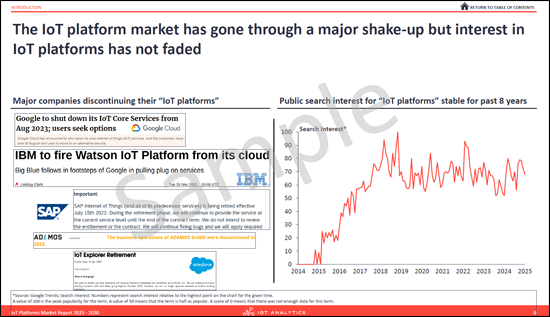
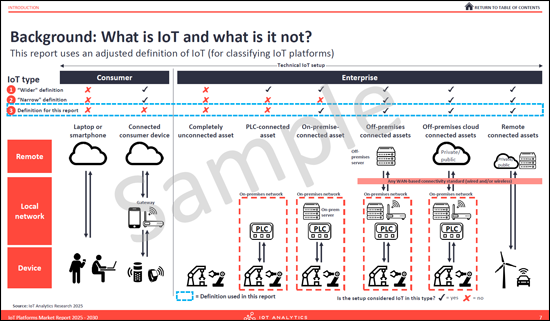
由於技術創新、供應商整合和業務需求的變化,物聯網平台市場持續快速發展。對於該生態系統的領導者來說,詳細客觀的了解至關重要,以便在這些重大變革中保持領先。
樣品預覽
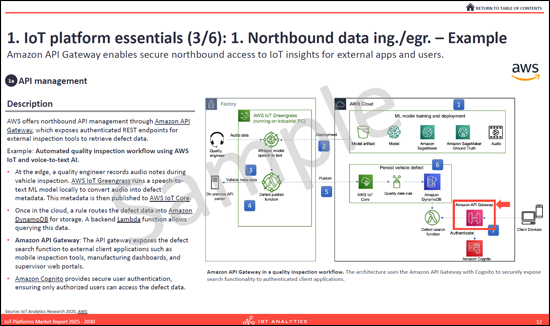
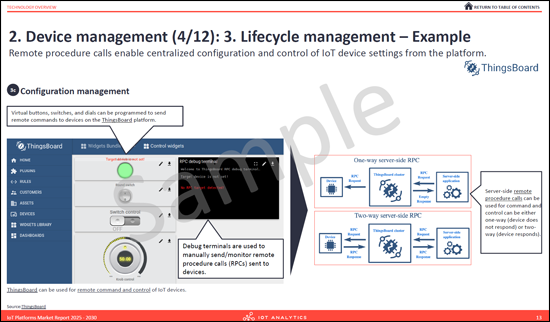
報告概述
- PDF 報告(第 228 頁):企業與工業物聯網平台市場格局的詳細概述。
- Excel 資料表:完整的市場模型,包含截至 2030 年的預測以及 500 多家物聯網平台公司的清單。
- 12 家領先供應商分析:介紹目前市佔率以及五家領先供應商的詳細資料。
- 五家公司案例研究:詳細介紹實際實施藍圖。
- 五大關鍵趨勢、五大挑戰與兩大考量分析:關鍵市場動態的未來展望。
樣品預覽
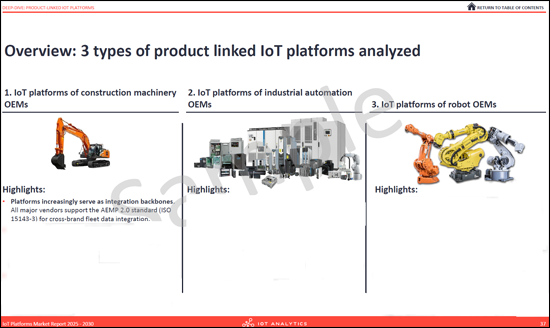
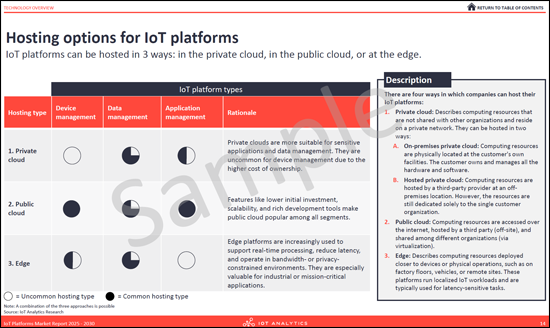
關鍵問題解答:
- 什麼是物聯網平台?它的定義和範圍是什麼?
- 近年來物聯網平台市場發生了哪些變化?
- 物聯網平台堆疊包含哪些層、元件和子元件?
- 按地區和產業劃分的物聯網平台市場規模是多少?
- 主要的物聯網平台供應商有哪些?它們之間有何比較?
- 有哪些值得關注的物聯網平台應用案例?
- 建築、工業自動化和機器人領域的物聯網平台有哪些特色?
- 物聯網平台領域的主要趨勢和挑戰是什麼?
刊載企業
|
|
|
目錄
第1章 摘要整理
第2章 簡介
第3章 技術概要
第4章 市場規模與展望
- 概述
- 廣義物聯網平台市場
- 狹義物聯網平台市場
- 物聯網平台市場過去十年的演變十年
- 2025年物聯網平台市場的一般驅動因素與限制因素
- 全球物聯網平台支出(依層級)
- 全球物聯網平台支出(按地區)
- 東亞及太平洋地區物聯網平台支出(按國家/地區)
- 北美物聯網平台支出(按國家/地區)
- 歐洲及中亞地區物聯網平台支出(依國家/地區)
- 全球物聯網平台支出(依產業垂直領域)
第5章 競爭情形
第6章 案例研究
第7章 深入探討:超大規模物聯網平台
第8章 深入探討:產品聯合IoT平台
第9章 趨勢與課題
第10章 調查手法和市場定義
第11章 關於IoT Analytics
A 228-page report detailing the market for enterprise and industrial IoT platforms, incl. market size, competitive landscape, key trends and challenges.
Sample preview


Introduction
The IoT platforms market continues to evolve at a rapid pace, driven by technological advancements, vendor consolidation, and shifting enterprise needs. For leaders invested in this ecosystem, staying ahead requires a detailed and objective understanding of these structural changes.
As part of IoT Analytics' ongoing coverage of IoT platforms and software, this report's main purpose is to help readers understand the current IoT platform landscape by defining, sizing, and analyzing the market. The information presented is based on the results of a survey, secondary research, and qualitative primary research, including interviews with IoT platform experts, vendors, and end users.
The result is a 228-page, data-driven analysis of the current and future state of the IoT platforms market. It includes definitions for the IoT platform and its components, market projections, analysis of the competitive landscape, a deep dive into hyperscalers' IoT platforms and product-linked IoT platforms, key trends and challenges, and case studies. The report is compiled to serve as a foundational intelligence asset for leaders responsible for strategy, product development, and investment within the IoT space.
Sample preview


Report at a glance
- 228-page PDF report: A detailed document outlining the enterprise and industrial IoT platforms market landscape.
- EXCEL datasheet: Includes the full market model and forecasts to 2030 & a list of +500 IoT platform companies.
- Analysis of 12 leading vendors: With current market shares and in-depth profiles of 5 key vendors.
- 5 enterprise case studies: Detailing real-world implementation blueprints.
- Analysis of 5 key trends, 5 challenges, and 2 further considerations: A forward-looking view of key market dynamics.
Sample preview


The report's analysis includes an in-depth look at several key areas:
- Market structure & evolution: An examination of the market's development over the past 10 years, including the initial proliferation of vendors, subsequent market exits, and the pivot toward solution-based models.
- Competitive landscape and vendor positioning: A detailed assessment of the top 12 vendors.
- Technology stack deep dive: A granular breakdown of the modern IoT platform into its 5 core layers and 14 key components, providing a technical baseline for product and development teams. The report further analyzes the specific platform architectures of both hyperscalers and product-linked OEMs in dedicated chapters.
- Real-world adoption and implementation patterns: An analysis of five distinct enterprise case studies, detailing the architectural decisions, challenges, and outcomes of IoT platform deployments at large industrial and technology firms.
A data-driven foundation for key business functions:
This research is designed to provide a data-driven foundation for key business functions:
- For corporate strategy & M&A: The report's market sizing, forecasts, and competitive landscape analysis provide the quantitative and qualitative backing needed to assess market entry, evaluate investment opportunities, and perform due diligence.
- For product management & marketing: The detailed analysis of vendor strategies, technology trends, and real-world use cases offers the necessary intelligence to benchmark product roadmaps, refine value propositions, and identify differentiation opportunities.
- For CTOs & technical leadership: The in-depth technology overview and architectural breakdowns of leading platforms provide a clear view of the current best practices and future technological trajectory of the market.
- For market intelligence & analysis: This report serves as a central, objective source of market data and vendor intelligence, enabling teams to build upon our findings for their own internal briefings and analyses.
What is an IoT platform?
Definition:
An IoT platform is a software-based technical platform that provides the necessary components for building and operating multiple IoT solutions. IoT platforms act as a middleware layer designed to:
- Manage connected devices.
- Collect and process their data.
- Enable the development and management of IoT applications and services.
Core components:
An IoT platform consists of 5 distinct layers, 14 components, and 44 sub-components:
- Essentials: These components enable bi-directional data exchange between IoT devices and the IoT platform (southbound), and between the IoT platform and external applications or services (northbound).
- Device management: This layer comprises lifecycle management, monitoring, firmware & software updates, and device security. It enables processes from device registration to retirement, tracks device health, delivers OTA updates, and enforces security.
- Data management: This layer spans IoT data transformation, digital twin modeling, analytics, and data security. It ensures data quality, builds digital replicas of physical assets, delivers insights, and protects data.
- Application management: This layer covers application development, lifecycle management, marketplace, and application security. It provides toolkits for building applications, enables deployment and updates, and ensures secure APIs.
Questions answered:
- What are IoT platforms and what is included in their scope (i.e., IoT platform definition)?
- How did the IoT platform market change in the last years?
- Which layers, components, and sub-components are included in the IoT platform stack?
- What is the total market size of IoT platforms by regions and industries?
- Who are the leading IoT platform vendors and how do they compare to each other?
- What are some notable IoT platform case studies?
- What are some of the specifics of IoT platforms in construction, industrial automation, and robotics?
- What are the key trends and challenges in the IoT platforms space?
Companies mentioned:
A selection of companies mentioned in the report.
|
|
|
Table of Contents
1. Executive Summary
2. Introduction
3. Technology overview
4. Market size & outlook
- 4.1. Overview
- 4.2. Wider IoT Platform Market
- 4.3. Narrow IoT Platform Market
- 4.4. How the IoT platforms market evolved over the past 10 years
- 4.5. General drivers and inhibitors for the IoT platforms market 2025
- 4.6. Global spending on IoT platforms by layer
- 4.7. Global spending on IoT platforms by region
- 4.8. Global spending on IoT platforms by country in East Asia & Pacific
- 4.9. Global spending on IoT platforms by country in North America
- 4.10. Global spending on IoT platforms by country in Europe and Central Asia
- 4.11. Global spending on IoT platforms by industry










